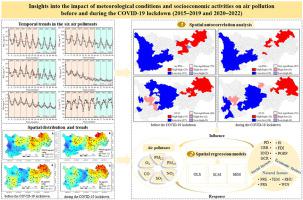当前位置:
X-MOL 学术
›
Atmos. Environ.
›
论文详情
Our official English website, www.x-mol.net, welcomes your feedback! (Note: you will need to create a separate account there.)
Response of air pollution to meteorological conditions and socioeconomic activities associated to the COVID-19 outbreak in the Yangtze River Economic Belt
Atmospheric Environment ( IF 5 ) Pub Date : 2024-02-03 , DOI: 10.1016/j.atmosenv.2024.120390 Jingjing Si , Lin Zhang , Shizhuang Zhang , Yongjian Li , Zhixin Zhang , Ziqi He , Ying Chen , Hongbin Zhan
Atmospheric Environment ( IF 5 ) Pub Date : 2024-02-03 , DOI: 10.1016/j.atmosenv.2024.120390 Jingjing Si , Lin Zhang , Shizhuang Zhang , Yongjian Li , Zhixin Zhang , Ziqi He , Ying Chen , Hongbin Zhan

|
The Yangtze River Economic Belt (YREB) in China is one of the most populated regions in the world with fast growth of economy and pollutant emissions from human activity, which has contributed to severe air-quality issues and detrimental impact on human health. China's measures to control the spread of COVID-19 appear to have resulted in reductions in energy consumption and in air pollutant emissions. However, there is a scarcity of studies that examine how natural meteorological and socioeconomic factors collectively influence the temporal and spatial variations of air pollution in the YREB before and during the COVID-19 lockdown. In this study, we analyze spatiotemporal evolution of air pollutants in the YREB during the period of 2015–2022, and estimate their spatial dependence, clustering characteristics, spillover effects, and response to multiple natural and socioeconomic variables. Significant decreasing trends were observed for major air pollutants except O. Although there were a 24.44% reduction in PM exposure in the YREB before the COVID-19 outbreak and a 7.60% reduction during the outbreak due to clean air measures, O exposure in the warm seasons (April–September) increased by 13.74% before the outbreak and 9.29% during the outbreak. At the spatial level, the highest concentrations of six air pollutants were recorded in urban agglomerations of the lower or middle reaches of the Yangtze River. A significant spatial autocorrelation of annual average concentrations for six air pollutants was detected in the YREB before and during COVID-19 outbreak. Meteorological conditions and socioeconomic activities potentially had significant impacts on air pollution concentrations. Prior to the implementation of COVID-19 control measures, both natural and socioeconomic factors collectively dominated air quality changes in the YREB. However, following the epidemic, the influence of natural factors on air pollution far outweighed that of the socioeconomic index. The finding of this study has profound implications for formulating emission reduction policies customized to the YREB regions in China.
更新日期:2024-02-03



























 京公网安备 11010802027423号
京公网安备 11010802027423号